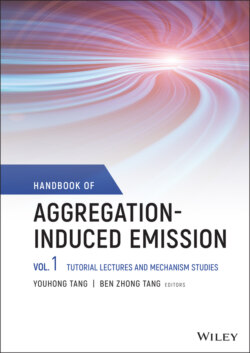Читать книгу Handbook of Aggregation-Induced Emission, Volume 1 - Группа авторов - Страница 35
2.3.2 Stretching Vibrations of Bonds
ОглавлениеTerephthalic acid (TPA) is a representative AIEgen, which could emit both fluorescence and phosphorescence simultaneously [41]. Through a combined QM/MM approach, the photophysical properties of TPA in both gas phase and crystal were investigated to unravel the effect of crystallization on the nature of the molecular excited states. It is found that the nature of S1 changes from (n,π*) in the gas phase to (π,π*) in crystal because the excitation energy of (n,π*) is increased up to 5.05 eV from 4.81 eV, whereas the (π,π*) state is reduced to 4.76 eV from 4.99 eV due to the strong electrostatic interaction upon aggregation. Accordingly, the oscillator strength of S1 is largely enhanced to 3.49 × 10−2 in the crystalline phase from 3.33 × 10−5 in the gas phase, which recovers the radiative decay from S1 to S0. And the resultant kr is largely increased by 3 orders of magnitude from 3.34 × 104 s−1 in the gas phase to 3.43×107 s−1 in the solid phase.
Table 2.1 Calculated HOMO–LUMO energy gap (∆Eg), electric transition dipole moment (μ), total reorganization energy (λtotal), kr, kic, and ΦF in gas phase and aggregate phase at room temperature for HPS, TPS, BrTPS, BTPES, and BFTPS, respectively.
| ∆Eg (eV) | μ (Debye) | λ total (meV) | k r (s−1) | k ic (s−1) | Φ F (%) | |
|---|---|---|---|---|---|---|
| In gas phase | ||||||
| HPS [37] | 3.59 | 5.20 | 492 | 1.05 × 107 | 3.76 × 1011 | 0.003 |
| TPS [38] | 3.21 | 0.58 | 1120 | 9.30 × 105 | 1.62 × 1010 | 0.01 |
| BrTPS [38] | 2.90 | 1.71 | 1161 | 5.55 × 106 | 5.72 × 109 | 0.09 |
| HPS [38] | 2.62 | 5.26 | 891 | 4.98 × 107 | 2.53 × 1010 | 0.20 |
| BTPES [38] | 2.48 | 6.03 | 667 | 6.76 × 107 | 2.66 × 1010 | 0.25 |
| BFTPS [38] | 2.36 | 9.54 | 821 | 1.22 × 108 | 1.66 × 109 | 6.86 |
| In solid phase | ||||||
| HPS [37] | 3.48 | 5.85 | 403 | 6.56 × 107 | 2.06 × 107 | 76.0 |
| TPS [38] | 3.26 | 0.60 | 932 | 1.15 × 106 | 3.32 × 106 | 25.8 |
| BrTPS [38] | 2.91 | 1.80 | 890 | 8.12 × 106 | 1.50 × 106 | 82.3 |
| HPS [38] | 2.70 | 5.90 | 753 | 7.43 × 107 | 1.57 × 106 | 97.9 |
| BTPES [38] | 2.49 | 5.75 | 592 | 6.57 × 107 | 1.93 × 106 | 97.1 |
| BFTPS [38] | 2.30 | 9.10 | 607 | 1.14 × 108 | 1.07 × 107 | 91.4 |
The reorganization energy analysis from S1 → S0 process for each normal mode in the gas phase reflects that the C=O stretching vibration contributes the most (∼1974.37 cm−1), consistent with the corresponding large structural modification (0.08 Å between S0 and S1). However, in the solid phase, this value is reduced to 212.96 cm−1 and the corresponding structural change is only 0.01 Å. Such a remarkable reduction is due to the alternation to π → π* electronic transition, which is decoupled with the C=O stretching vibration. As a result, from the gas to solid phases, kic decreases about 1 order of magnitude from 4.97 × 107 to 5.15 × 106 s−1. That is, the nonradiative decay process is blocked by the decoupling between the high‐frequency C=O stretching vibration and transition electrons (Figures 2.2c and 2.4b). Overall, the largely accelerated radiative decay rate and slowed nonradiative decay rate induce the observed strong fluorescence in the solid phase [41].
